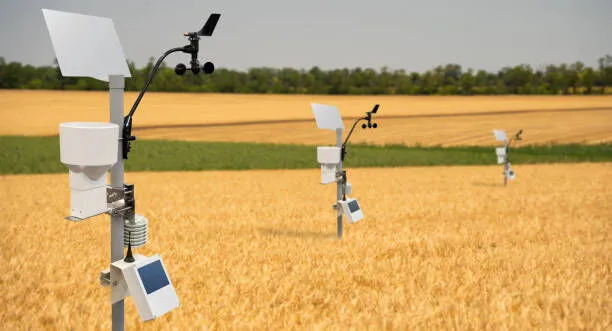On this page
Weather sensors play a vital role in accurately monitoring and predicting weather conditions, essential for a wide range of applications, from agriculture to aviation. With advancements in technology, weather sensors have become more precise, reliable, and accessible, providing real-time data to help industries and individuals make informed decisions. In this article, we will explore the different types of weather sensors, how they work, and the benefits they offer.
There are many types of weather sensors, each measuring specific elements of the environment.

There are many types of weather sensors, each measuring specific elements of the environment.
Measure air temperature.
Track humidity levels.
Record wind speed and direction.
Monitor atmospheric pressure.
Measure the amount of precipitation.
Detect solar radiation levels.
Each of these sensors plays a crucial role in providing data that contributes to a comprehensive understanding of the weather.
Each of these sensors plays a crucial role in providing data that contributes to a comprehensive understanding of the weather.
Different types of weather sensors function based on their design and purpose. Here's how some of the most common weather sensors work:
These sensors measure temperature using a temperature-sensitive material that expands or contracts as the temperature changes. Digital thermometers convert this change into electrical signals that are displayed as temperature readings.
Hygrometers use materials that change their electrical resistance or capacitance with varying moisture levels in the air, translating into humidity measurements.
Typically equipped with rotating cups or propellers, anemometers measure wind speed by calculating the rotational speed, while wind vanes indicate the direction of the wind.
Barometers measure atmospheric pressure by using mercury, aneroid cells, or other sensors that respond to pressure changes.
These devices measure precipitation by collecting rainwater in a funnel and calculating the depth or volume of the liquid.
Pyranometers use thermocouples or photodiodes to measure the amount of solar radiation, which is useful for determining solar energy levels.
Each of these sensors uses specific physical properties to capture environmental data, which is then transmitted for analysis, recording, or display in weather forecasting systems.
Each of these sensors uses specific physical properties to capture environmental data, which is then transmitted for analysis, recording, or display in weather forecasting systems.
Weather sensors are used across numerous sectors and industries that rely on accurate weather data for decision-making. Some key applications include:
Farmers use weather sensors to monitor soil moisture, temperature, and humidity, which helps in crop planning, irrigation, and frost protection.
Airports and airlines rely on weather sensors to ensure flight safety by monitoring wind speed, visibility, and other critical atmospheric conditions.
Weather sensors help ships and offshore platforms monitor oceanic weather conditions such as wind speed, wave height, and atmospheric pressure, ensuring safe navigation.
Weather conditions can impact building projects, so sensors help managers track potential weather disruptions such as high winds, rain, or freezing conditions.
Meteorological agencies use weather sensors for storm detection and forecasting, which helps in issuing timely warnings for extreme weather events like hurricanes, floods, and heatwaves.
Wind farms and solar power plants rely on sensors to optimize energy production by tracking wind speeds and solar radiation levels.
In all these industries, weather sensors provide vital information that helps to enhance safety, optimize operations, and improve decision-making.
In all these industries, weather sensors provide vital information that helps to enhance safety, optimize operations, and improve decision-making.
Weather sensors offer several advantages that make them indispensable tools for a variety of industries and applications:
Weather sensors provide precise measurements of key atmospheric variables, ensuring reliable data for forecasting and monitoring.
Sensors collect data in real-time, allowing for timely responses to changing weather conditions. This is especially critical for industries like aviation and agriculture, where rapid changes in weather can have significant impacts.
With advanced weather sensors, data collection can be fully automated, reducing the need for manual intervention and minimizing the risk of human error.
By providing early warnings of extreme weather events, sensors help prevent costly damage to property and infrastructure, saving resources in the long term.
Weather sensors play a critical role in improving safety by offering predictive insights that allow industries to mitigate risks associated with adverse weather conditions.
In the renewable energy sector, weather sensors enable efficient use of natural resources by optimizing wind and solar energy production.
The combination of accuracy, real-time data, and automation makes weather sensors a crucial investment for businesses, governments, and individuals who depend on up-to-the-minute weather information.
The combination of accuracy, real-time data, and automation makes weather sensors a crucial investment for businesses, governments, and individuals who depend on up-to-the-minute weather information.
Weather sensors are essential for capturing detailed and accurate atmospheric data, benefiting a wide range of industries and applications. By understanding the different types of weather sensors, their working principles, and the advantages they provide, users can harness their potential to make informed decisions that improve safety, efficiency, and sustainability. Whether in agriculture, aviation, construction, or renewable energy, weather sensors play a pivotal role in navigating the ever-changing conditions of our environment.
Previous: How to Monitor Indoor Air Quality for Healthier Buildings
Next: Do Air Purifiers Really Work?




